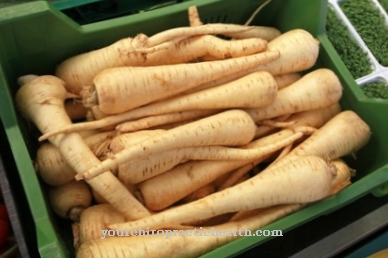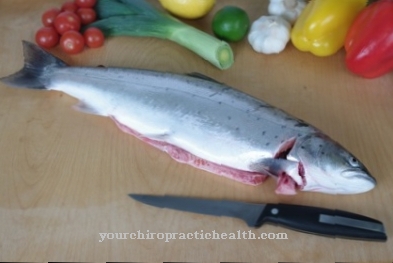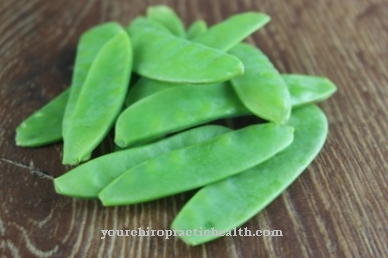One of the most commonly consumed vegetables is that tomato. The nightshade plant is used both raw and cooked. Thanks to its valuable ingredients, tomatoes make an important contribution to health.
What you should know about the tomato

The name "tomato" is derived from the Aztec "xictomatl" for "swell". What is meant is the ripening of the originally firm green berries into bulging tomatoes. These usually have a red skin.
During the ripening process, the green chlorophyll is broken down and replaced by red lycopene. The color spectrum goes from orange to yellow, sometimes purple or even black, depending on the breed. Round specimens are most commonly consumed. Tomatoes are quite soft and quickly pop open under pressure. Inside there is mainly amniotic fluid (over 90%). The firmer pulp can be found under the skin. Below that, the seeds are fan-like embedded in a gelatinous tissue. Tomatoes taste noticeably different depending on their cultivation and degree of ripeness. A certain enzyme is responsible for this, which destroys the bitter acid of the vegetable. Smaller tomatoes such as the popular cherry tomatoes contain less water and taste more intense.
Originally, the tomato was only found in South America and was used by the Mayans and Aztecs. Later it was more and more widespread in North America, where it was brought to Europe by Columbus at the end of the 15th century. In the meantime, tomatoes are grown almost all over the world both in wide fields, in huge greenhouses and in the home garden. Maturing is particularly suitable in warm summer with lots of sun, as is practiced in Spain, for example. The Federal Republic of Germany sources a large part of its imported tomatoes from there.
In first place, by far, are the Netherlands with their rather watery tomatoes. Domestic cultivation is not quite as pronounced. Nevertheless, the tomato is currently the most widely consumed vegetable in Germany. The average German eats around 20 kilograms per year. The berry of the plant, which is usually grown as an annual, can be bought all year round in the supermarket. It tastes best in and after the summer months.
Importance to health
The popular tomato is indispensable as a component of a balanced diet. The thirteen vitamins as well as the valuable minerals and fiber help the body to stay healthy. The preventive effect to avoid cardiovascular diseases has been proven.
The risk of stroke is reduced by half with regular consumption. Research is currently underway into the relationship between tomato consumption and the decline in new cancer cases. The most important ingredient in tomatoes is the secondary plant substance lycopene. This is otherwise only found in significant concentrations in rose hips, grapefruits and watermelons. One tomato is enough to cover the daily requirement. Lycopene strengthens the skin cells and promotes internal protection against sunburn. Lycopene also lowers cholesterol and prevents coronary heart disease and arteriosclerosis.
The consumption of tomatoes also has positive effects on wound healing, the resilience of hair and nails and the immune system in general. Tomatoes are also said to lighten the mood and increase nerve strength. Tomato ketchup should be avoided despite the high proportion of tomatoes. A standard ketchup bottle (500 ml) contains around 110 grams of pure sugar, i.e. 35 sugar cubes.
Ingredients & nutritional values
| Nutritional information | Amount per 100 gram |
| Calories 18 | Fat content 0.2 g |
| cholesterol 0 mg | sodium 5 mg |
| potassium 237 mg | carbohydrates 3.6 g |
| protein 0.9 g | vitamin C 13.7 mg |
Tomatoes are great for losing weight. A tomato of 50 grams contains only 9 calories with a carbohydrate amount of 1.8 g. Protein and fat are also negligible. About 94% of a tomato is water. Thirteen vitamins can be detected, including at least 10 mg vitamin C. Vitamins B1, B2, B6, E and K as well as niacin are also important.
In terms of minerals, potassium comes first at around 120 mg, followed by phosphorus, magnesium, calcium, sodium and iron. In addition to folic acid and (beta) carotene, the aforementioned lycopene is an important secondary plant substance. The peel is indigestible and is excreted by the body.
Intolerances & allergies
For most people, eating tomatoes is not a problem. However, there are intolerances. Sensitive people can experience painful digestive disorders from eating the shell. We recommend peeling beforehand. A "tomato allergy" can often be traced back to a histamine intolerance.
The symptoms are digestive problems and headaches, but also palpitations or itchy skin rashes. People with hay fever can react negatively to tomatoes in the form of a cross allergy, for example with itching and swelling in the mouth region. Chemically, individual molecules in tomatoes are closely related to bee pollen. The negative effects can be avoided if the tomato is cooked.
Shopping & kitchen tips
Fresh tomatoes should mainly be bought in late summer. Then they are the most intense in taste. In the winter months, canned tomatoes are a better and healthier choice.
Even if modern tomatoes stay firm for several weeks, they lose more and more of their valuable ingredients. Therefore, it is advisable to consume it soon. More exotic varieties can be purchased at weekly markets or at farm sales. These have a wide range of flavors. There are also tasty green tomatoes here. Unripe green tomatoes, on the other hand, are poisonous and should not be tried. Tomatoes do not tolerate cold. Storage in the refrigerator is therefore ruled out. It is better to store tomatoes in a cool place (around 15 ° C) in an airy and shady place.
A specialty of tomatoes is the high emission of ethylene. This ripening gas allows other types of fruit and vegetables, such as cucumbers, to spoil more quickly. Both tomatoes and apples go bad faster when stored near apples. This effect can be used to allow hard fruits (such as a kiwi) to ripen in a targeted manner. Otherwise, tomatoes must be stored individually. A soft cloth under the fruit prevents pressure points. Tomatoes dried in the oven can be kept for several months and have an extremely intense taste.
Preparation tips
Tomatoes can be used in many ways in the kitchen. Raw they are suitable for any form of salad or as a snack. To make the salad taste more like tomatoes, we recommend removing the seeds and jelly. This way the lettuce does not water again and stays fresh longer. When cooked, tomatoes are used for sauces, casseroles or pizzas. Canned tomatoes can be used here.
In the case of fresh tomatoes, the peel should be removed beforehand. To do this, scratch the fruit in a cross shape and immerse it in hot water for a few seconds. The shell can then be peeled off quickly. Industrially produced tomato paste tastes particularly intense like tomatoes. This should be roasted briefly. Also available are strained tomatoes, a form of pure tomato juice used as a base for sauces. Tomato ketchup is not only popular with fries and sausages, but should be consumed in moderation.



























